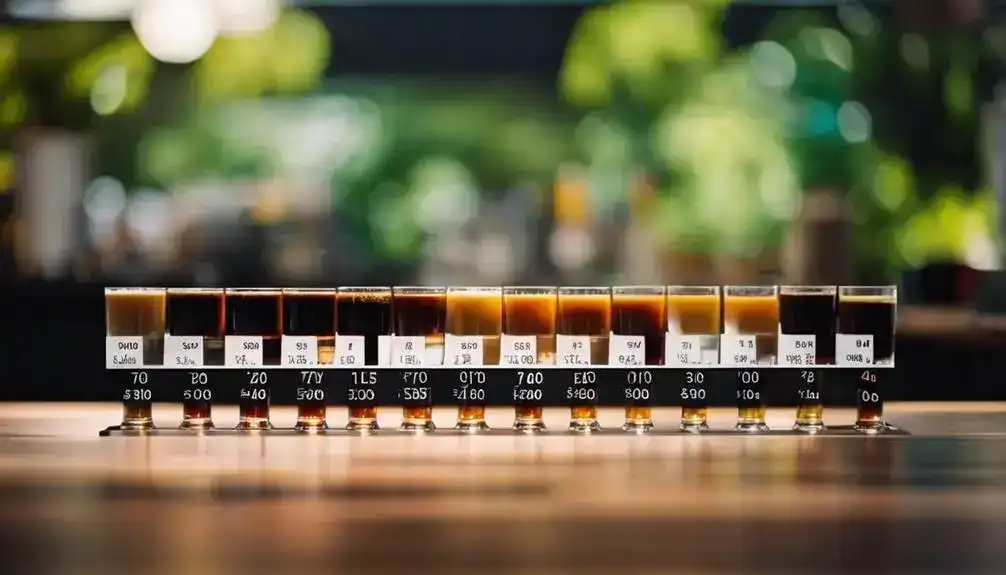If you think you know the acidity levels in your cold brew coffee, think again. The truth behind the acidity in this beloved beverage might surprise you.
Understanding the intricacies of cold brew acidity can lead to a whole new appreciation for your morning cup. So, before you take that next sip, consider what really lies beneath the surface of your cold brew’s acidity levels.
As a seasoned coffee connoisseur with years of experience in the specialty coffee industry, I bring expert knowledge and insights to uncover the real levels of acidity in cold brew coffee.
Acidity Levels in Cold Brew

When comparing acidity levels in cold brew to hot brew coffee, you’ll notice significant differences that affect the flavor profile. Understanding how cold brew acidity compares to espresso and iced coffee can enhance your appreciation for the complexities of different coffee brewing methods.
Exploring the pH of cold brew coffee and how acidity is measured using the pH scale will provide insights into the science behind these flavor variations.
Acidity Levels in Cold Brew vs. Hot Brew Coffee
Cold brew coffee typically boasts lower acidity levels compared to its hot brew counterpart. This difference occurs because the cold brewing process involves steeping coffee grounds in cold water for an extended period, usually 12-24 hours, resulting in a smoother, less acidic taste. On the other hand, hot brew coffee is brewed quickly with hot water, leading to higher acidity levels due to the faster extraction of compounds from the beans. Additionally, the bean origin plays a crucial role in determining the acidity profile of the coffee, with beans from regions like Ethiopia often showcasing fruity and bright acidity, while beans from Brazil tend to have lower acidity levels.
| Aspect | Cold Brew Coffee | Hot Brew Coffee |
|---|---|---|
| Brew Time | 12-24 hours | Quick brewing process |
| Acidity Levels | Lower | Higher |
| Bean Origin | Influences acidity profile | Influences acidity profile |
Cold Brew vs. Espresso: Acidity Levels
Comparing the acidity levels between cold brew and espresso reveals distinct differences in flavor profiles. Cold brew coffee typically has lower acidity levels compared to espresso, making it a smoother and less bitter option. This difference stems from the brewing process; Cold brew is steeped in cold water for an extended period, resulting in a milder taste. Espresso is brewed quickly using hot water under pressure, intensifying its acidity. Here’s a comparison table detailing key differences:
| Aspect | Cold Brew | Espresso |
|---|---|---|
| Acidity Level | Lower | Higher |
| Antioxidant Content | High | Moderate |
| Caffeine Levels | Similar | Higher |
Understanding these distinctions can help you choose the coffee best suited to your preferences and health needs. For those looking for a less acidic option, cold brew might be the way to go.
Cold Brew Acidity vs. Iced Coffee
To understand the difference in acidity levels between cold brew and iced coffee, consider their distinct brewing methods and how they impact flavor profiles. Cold brew is steeped in cold water for an extended period, typically 12-24 hours, resulting in a smoother, less acidic taste. On the other hand, iced coffee is brewed hot and then poured over ice, preserving more of its acidity. The brewing techniques and temperature control play a crucial role in the final taste. Some may prefer the bold, acidic punch of iced coffee, while others lean towards the milder, less acidic notes of cold brew. Understanding these nuances can help you choose which suits your acidity perception and taste preferences best.
| Aspects | Cold Brew | Iced Coffee |
|---|---|---|
| Brewing Method | Steeped in cold water | Brewed hot, poured over ice |
| Temperature Control | Cold water | Hot water |
| Acidity Level | Lower | Higher |
pH of Cold Brew Coffee
Have you ever wondered whether cold brew coffee is alkaline? Let’s break down the acidity levels in cold brew coffee to see if it leans towards the alkaline side. Check out the table below for a quick comparison of the pH levels in different types of coffee:
| Coffee Type | pH Level |
|---|---|
| Cold Brew | 6.5-6.8 |
| Espresso | 4.9-5.1 |
| Drip Brew | 5.83-6.0 |
Is Cold Brew Coffee Alkaline?
Cold Brew Coffee can have varying levels of alkalinity, impacting its pH and overall taste profile.
- Cold brew coffee is generally less acidic than hot brewed coffee.
- The slow steeping process of cold brew coffee can result in a smoother taste.
- Alkaline benefits may include reduced bitterness and a more balanced flavor profile.
- pH levels in cold brew can vary depending on brewing methods.
- Contrary to myths, cold brew coffee can be alkaline.
Measuring Coffee Acidity: The pH Scale
When measuring coffee acidity using the pH scale, it’s essential to understand the impact this factor has on the taste and texture of your cold brew. To help you grasp this concept more effectively, here are some key points to consider:
- The pH scale measures acidity levels
- Acidity affects flavor and body
- Personal experiences with cold brew and acid reflux
- Understanding acidity can enhance your coffee enjoyment
- pH plays a significant role in determining coffee quality
How Acidity Affects Flavor and Body
Understanding how acidity influences the flavor and body of cold brew coffee is essential for appreciating its unique characteristics.
- Acidity Balance: Achieving the perfect balance enhances the overall flavor profile.
- Flavor Profile: Acidity levels can vary, affecting the taste from bright and tangy to smooth and mellow.
- Body Sensation: Acidity impacts the perceived weight and texture of the coffee.
- Brewing Methods: Different brewing methods can alter acidity levels.
- Uniqueness: Embracing acidity can lead to innovative and exciting flavor experiences.
Personal Experiences with Cold Brew and Acid Reflux
Have you ever wondered how your personal experiences with cold brew coffee relate to acid reflux and its acidity levels? Whether you’re a coffee enthusiast or someone struggling with acid reflux, personal anecdotes can shed light on this connection.
- Cold brew’s lower acidity might be gentler on your stomach.
- Experimenting with different brewing times can impact acidity levels.
- Some individuals find cold brew less irritating to acid reflux compared to hot coffee.
- Adding milk or alternative creamers can help reduce acidity.
- Pay attention to your body’s reactions to determine the best choice for you.
Factors Influencing Acidity in Cold Brew Coffee

When making cold brew coffee, the acidity levels can be influenced by several key factors. The type of coffee beans you choose, the roasting process, brewing time, water temperature, and filtration techniques all play a role in determining the acidity of your final brew.
Understanding how these elements interact can help you tailor your cold brew to achieve the acidity levels you desire.
Type of Coffee Beans Used
Choosing the right type of coffee beans significantly impacts the acidity levels in your cold brew coffee. When selecting beans for your cold brew, consider the following factors:
- Bean Selection: Different coffee varieties like Ethiopian Yirgacheffe or Kenyan AA can offer unique flavor profiles that affect acidity levels.
- Geographical Origin: Beans from different regions have distinct acidity levels due to varying growing conditions.
- Processing Methods: Natural or washed processing methods can influence the acidity of the final cold brew.
- Roast Level: Lighter roasts tend to preserve the beans’ natural acidity, while darker roasts might mellow it.
- Blend Composition: Single-origin vs. blends can alter the acidity profile of your cold brew significantly.
Ensure to experiment with these factors to find the perfect acidity level that suits your taste preferences.
Roasting Process
Opting for a lighter roast when preparing your cold brew coffee can enhance the natural acidity of the beans. Different roasting techniques can significantly impact the flavor profiles of your cold brew. Consider the following when choosing the right roast for your cold brew coffee:
- Single Origin Roasts: Explore single origin roasts that highlight the unique flavors of specific regions.
- Blending Techniques: Experiment with blending different roasts to create complex and balanced flavor profiles.
- Roast Level: Adjust the roast level to control the acidity and overall taste of your cold brew.
- Roast Development: Pay attention to the roast development process to bring out specific flavor notes.
- Roast Freshness: Use freshly roasted beans to ensure the best flavor in your cold brew.
Brewing Time and Water Temperature
To enhance the acidity levels in your cold brew coffee, consider adjusting the brewing time and water temperature. When experimenting with these factors, you can truly unlock the full potential of your brew strength and flavor profile. Here are some key points to keep in mind:
- Optimal Steeping Time: Longer steeping times can intensify the acidity in your cold brew.
- Water Temperature: using cold water for a longer duration can lead to a smoother, less acidic brew.
- Balancing Extraction Rate: Adjusting the extraction rate can help tailor the acidity to your preference.
- Experimentation is Key: Don’t be afraid to try different combinations to find your perfect acidity level.
- Consistency Matters: Keep track of your brewing parameters to replicate your desired flavor profile consistently.
Filtration Techniques and Their Effects on Acidity
When considering filtration techniques in cold brew coffee preparation, the method you choose can significantly impact the acidity levels of your final brew. The effects of filtration on acidity in cold brew coffee are crucial in determining the overall taste profile. Here are some insights to consider:
- Paper Filters: Absorb oils, resulting in a smoother, less acidic brew.
- Metal Filters: Allow more oils to pass through, leading to a bolder, potentially more acidic flavor.
- Cloth Filters: Offer a middle ground, balancing acidity and richness.
- Mesh Filters: Can enhance body and mouthfeel, affecting how acidity is perceived.
- Slow Filtration: Allows for more extraction, potentially increasing acidity levels.
Experimenting with different filtration methods can help you tailor your cold brew coffee to your preferred acidity profile.
Reducing Acidity in Cold Brew Coffee

When aiming to decrease acidity in your cold brew coffee, focus on the selection of coffee beans and brewing techniques.
Opt for beans with lower acidity profiles and experiment with brewing methods that yield a smoother, less acidic result.
Selection of Coffee Beans
When aiming to reduce acidity in your cold brew coffee, the selection of coffee beans plays a crucial role. To achieve a smoother taste, opt for low-acid coffee bean varieties. Additionally, consider the impact of the roast level on acidity.
- Choose low-acid coffee bean varieties
- Opt for a lighter roast level
- Experiment with different origins
- Consider the processing method
- Blend different coffee beans
Low-Acid Coffee Bean Varieties
To reduce acidity in your cold brew coffee, consider selecting low-acid coffee bean varieties. These beans offer a smoother flavor profile and are less likely to cause digestive discomfort. Some popular low-acid coffee bean varieties include Brazilian Santos, Sumatra Mandheling, and Mexican Altura. Experimenting with different types can help you find the perfect balance of flavor and acidity for your cold brew.
| Low-Acid Coffee Bean Varieties | Acidity Level | Flavor Profile |
|---|---|---|
| Brazilian Santos | Low | Nutty, Chocolatey |
| Sumatra Mandheling | Low | Earthy, Herbal |
| Mexican Altura | Low | Sweet, Caramel |
Impact of Roast Level on Acidity
Considering the impact of roast level on acidity in cold brew coffee, the selection of coffee beans plays a significant role in achieving the desired flavor profile. Roast profiles can influence acidity levels, affecting acidity perception based on roasting levels. Experimenting with different roast profiles can help tailor the acidity of your cold brew to suit your preferences.
| Roast Profiles | Acidity Levels |
|---|---|
| Light Roast | High |
| Medium Roast | Moderate |
| Dark Roast | Low |
Brewing Techniques for Lower Acidity
To reduce the acidity in your cold brew coffee, consider using cold water and implementing filtration methods. By utilizing these techniques, you can create a smoother and less acidic brew that’s more enjoyable for your palate. Remember, adjusting your brewing methods can significantly impact the overall acidity of your cold brew coffee.
- Using Cold Water
- Implementing Filtration Methods
- Adjusting Brewing Time
- Experimenting with Ratios
- Trying Different Bean Roasts
Use of Cold Water
Using cold water instead of hot water is a key technique for reducing acidity in cold brew coffee.
- Cold water benefits: Preserves delicate flavors.
- Brewing methods: Slow extraction process with chilled water.
- Enhanced flavor profiles: Results in a smoother, less acidic coffee.
- Less bitterness: Cold water extraction reduces the bitterness often found in hot-brewed coffee.
- Gentle extraction: Helps maintain the natural sweetness of the coffee beans.
Filtration Methods to Reduce Acids
Implementing effective filtration methods is crucial for reducing acidity levels in cold brew coffee while enhancing its flavor profile. By utilizing innovative filtration techniques, you can achieve a smoother and less acidic cold brew experience.
Consider the following benefits of filtration methods:
- Enhanced smoothness
- Reduced bitterness
- Improved clarity
- Increased sweetness
- Balanced acidity
Health Aspects of Cold Brew Coffee Acidity
When considering the health aspects of cold brew coffee acidity, you’ll find that it can be a suitable choice for individuals dealing with acid reflux. Cold brew serves as a gentler alternative to traditional hot coffee, offering a smoother experience for sensitive stomachs.
Additionally, its nutritional advantages and compatibility with low-acid diets make it a versatile option for those seeking a milder coffee experience.
Cold Brew Coffee for Acid Reflux Sufferers
If you suffer from acid reflux, you might be wondering how cold brew coffee could impact your digestive health. Some people find that cold brew is gentler on their stomach compared to hot brewed coffee.
To help you understand this better, consider the following points:
- Personal Testimonies on Cold Brew and Digestive Health
- Recommendations for Acid Reflux Management
Personal Testimonies on Cold Brew and Digestive Health
Considering the potential health benefits of cold brew coffee for individuals with acid reflux, many have shared their personal testimonies on how it has positively impacted their digestive health.
- Reduced acidity levels
- Decreased bloating
- Improved digestion
- Lesser heartburn occurrences
- Enhanced overall gut comfort
Recommendations for Acid Reflux Management
For acid reflux sufferers looking to manage their symptoms effectively, incorporating cold brew coffee into your routine can be a beneficial choice due to its lower acidity levels.
Acid Reflux Prevention Tips:
- Avoid spicy and acidic foods.
- Eat smaller, more frequent meals.
- Maintain a healthy weight.
- Limit caffeine intake.
- Stay upright after eating.
Cold Brew as a Gentler Alternative
Cold brew coffee offers a gentler alternative due to its lower acidity levels, making it a suitable option for those with sensitive stomachs. By choosing cold brew, you can still enjoy the antioxidants and other beneficial compounds found in coffee without the harsh impact on your digestive system.
Consider these points when opting for cold brew:
- Reduced acidity compared to hot brewed coffee
- Smoother taste profile
- Lesser risk of heartburn
- Easier on the stomach
- Potential to be less irritating to acid reflux
Antioxidants and Other Beneficial Compounds in Cold Brew
When exploring the health benefits of cold brew coffee, you will find a rich source of antioxidants and other beneficial compounds that make it a gentler alternative for those seeking a lower acidity option. Cold brew antioxidants provide numerous benefits, such as improved heart health and reduced inflammation. To maximize these benefits, try varying brewing techniques and tips to extract the most antioxidants from your cold brew.
| Antioxidants | Benefits | Extraction Tips |
|---|---|---|
| Polyphenols | Heart health support | Coarse grind size |
| Chlorogenic acid | Reduced inflammation | Extended steeping time |
| Caffeic acid | Anticancer properties | Cold water brewing |
Nutritional Advantages of Cold Brew Over Hot Coffee
When considering the nutritional advantages of cold brew over hot coffee, you may find that cold brew offers a range of benefits. To better understand this, let’s look at some key points.
- Cold brew coffee tends to have higher antioxidant content compared to hot coffee.
- The caffeine levels in cold brew can vary, potentially impacting your daily intake.
- Cold brew is known for its smoother taste and lower acidity levels.
- Some people find cold brew easier on their stomach compared to hot coffee.
- The brewing process of cold brew may result in a different chemical composition than hot coffee.
Antioxidant Content Comparison
Comparing the antioxidant content between cold brew coffee and hot coffee reveals significant nutritional advantages of cold brew. Cold brew coffee typically contains higher levels of antioxidants due to its unique brewing method that involves steeping the coffee grounds in cold water for an extended period. This process helps extract more antioxidants compared to the traditional hot brewing method, providing potential health benefits to consumers.
| Antioxidant Content | Cold Brew Coffee | Hot Coffee |
|---|---|---|
| Level | Higher | Lower |
Caffeine Levels and Their Impact
With regards to caffeine levels and their impact, cold brew coffee offers distinct advantages over hot coffee in terms of health aspects. Cold brew coffee typically has lower caffeine levels compared to hot brewed coffee, making it a suitable choice for those sensitive to caffeine. Additionally, the smoother extraction process of cold brew results in a less acidic brew, reducing the chances of stomach irritation and acid reflux.
| Health Benefits of Cold Brew Coffee |
|---|
| 1. Lower caffeine levels |
| 2. Reduced acidity |
| 3. Decreased risk of stomach issues |
| 4. Potential for improved digestion |
| 5. Enhanced overall well-being |
Incorporating Cold Brew in Low-Acid Diets
If you’re looking to incorporate cold brew into your low-acid diet, there are some simple steps you can take. By following a few tips, you can make your own low-acid cold brew at home. Check out the list below for some helpful suggestions on how to achieve this:
- Use a coarser grind of coffee beans
- Steep the coffee for a longer period
- Try cold brewing with cold water instead of room temperature water
- Use a higher coffee to water ratio
- Experiment with different types of coffee beans
Tips for Making Low-Acid Cold Brew at Home
For those seeking a gentler coffee experience, crafting your own low-acid cold brew at home can be a simple and enjoyable process. To make low-acid cold brew, consider these tips:
- Experiment with different coffee bean varieties.
- Use a coarser grind to reduce acidity.
- Extend the brewing time for a smoother flavor.
- Try cold brewing with cold water instead of hot.
- Consider using a coffee maker designed for low-acid coffee.
Conclusion
In conclusion, understanding the acidity levels in cold brew coffee is crucial for coffee lovers. Factors like brew time and bean origin play a part in determining the acidity.
To reduce acidity, consider using a coarser grind or adjusting the brew time. Despite the acidity, cold brew coffee can still offer a refreshing and flavorful experience.
Remember, balancing acidity in cold brew is key for a smooth and satisfying sip!

